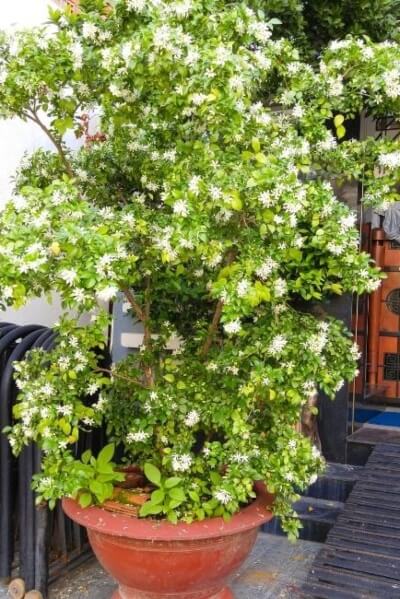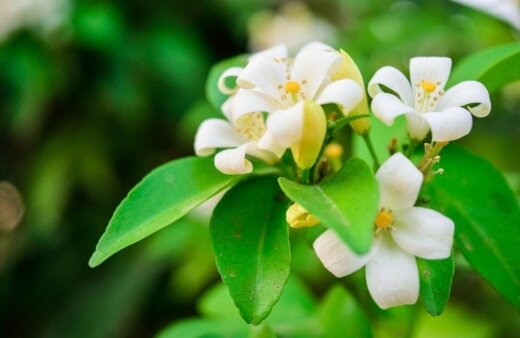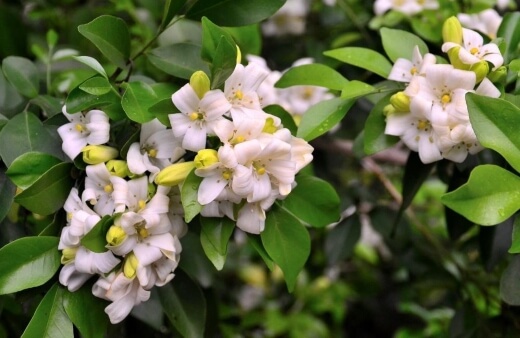Murraya paniculata is a species of small tree or shrubs with pretty white flowering that is sure to add beauty to your garden. They are known for their citrusy aroma and berries.
If you’re interested to know how to grow these gorgeous plants, keep reading. This growing guide will answer each and every query of yours with regards to growing Murraya paniculata.
More...
What Is Murraya paniculata?

Murraya paniculata is commonly known by nicknames that include orange jessamine, china box, orange jasmine, or mock orange. This plant belongs to the Rutaceae family which is native to South Asia, Australia, and Southeast Asia.
It has been used by indigenous Australians for centuries. This Plant has been used for many purposes. The leaves have been used as a tea, and the roots have been eaten to relieve stomach pain or diarrhoea.
The stems have also been used as an infusion to treat asthma and bronchitis, as well as a treatment for sore throat, coughs, and colds.
It can be found in different colours of red, orange, yellow, and green with white flowers that appear in the summer months.
Orange jessamine can grow up to 20 feet high and has large leaves that are green with purple veins and red stalks. The flowers of the plant are pale yellow to white and have petals that are up to 1 inch long.
Murraya Species
Murraya paniculata can be found in the wild or gardens and it has been used for centuries in cooking and medicine. There are many varieties of the plant which are discussed ahead.
There are seventeen species of this plant found globally. There is a variety of this plant found and each differs in size, colour, and fragrance.
The most common ones are:
- Murraya alata Drake
- Murraya crenulata (Turcz.) Oliv.
- Murraya euchrestifolia Hayata
- Murraya koenigii (L.) Spreng
- Murraya kwangsiensis (C.C. Huang)
- Murraya microphylla (Merr. & Chun) Swingle
Planting Murraya paniculata
The plant is an evergreen shrub that grows to a height of 2-6 feet. It has green leaves with a shiny appearance. The flowers are small, yellow, and green.
The plant is a popular ornamental shrub in warm regions such as the Mediterranean, Southern Europe, North Africa, and the Caribbean islands. It can be used as hedges or borders or as ground cover in gardens.

Murraya paniculata is a type of plant that can be found in the temperate and tropical regions of the world. It grows well in both light and moist soil. It is also a shade-loving plant, which means it likes to be under trees with leaves.
It has a unique ability to grow quickly and produce large amounts of leaves and flowers. It is also capable of producing roots that can take up nutrients from deep within the soil.
These roots are found all over the plant's body and they help it survive even when it is not receiving any direct nutrients from above ground. The plant has a deep taproot which allows it to grow deep into the ground and produce its food.
The roots also help to aerate the soil, making it easier for other plants to grow around it. It can be used for ornamental purposes by planting mock orange in water or soil. The plant has been used for medicinal purposes as well.
The plant's leaves are harvested and dried to be used as medicine, while the roots are ground into a powder and mixed with water to drink. The roots have been traditionally used to treat fever, coughs, diarrhoea, and indigestion.
The leaves can also be eaten raw or cooked with vegetables or meat dishes.
Planting mock orange is a process that requires soil preparation, planting in the ground, and monitoring the growth of the plant. The process can take up to two years to produce fruits.
How To Grow Murraya paniculata

China box is a hardy plant that requires little care, making it an ideal choice for beginning gardeners or those who live in areas with cold winters.
It does not need much sun to grow either, so it can be grown indoors during the winter months when the sun is scarce. The Orange Jasmine plant grows best in well-drained soil and full sunlight.
One way to grow these plants from seeds is by taking root cuttings. This can be done through the following steps:
- Step 1: Cut off a section of the stem of the plant, leaving at least two leaves.
- Step 2: Place the stem in moist potting soil. (Get the best potting mix here.)
- Step 3: Bury the cutting within the soil so that the soil forms a layer on top of it.
- Step 4: Water the plant stems well.
- Step 5: Soon the roots will start to grow out of the top of the cutting.
Another method for growing Murraya paniculata from seeds is by planting them directly into the soil. This can take place if the steps below are followed carefully:
- Step 1: Extract the seeds from the fruits of the plant by squeezing them out.
- Step 2: Place the seeds in a pot filled with peat and fertiliser.
- Step 3: Sow each seed at a distance of 1 inch.
- Step 4: Cover the seeds with peat properly.
- Step 5: Moist the soil using water and keep the pot in a bright location that is semi-shaded.
- Step 6: One week later you will be able to witness roots forming from the seeds.
Murraya Propagation

The Orange Jasmine plant can be propagated once the fruit ripens. The ripeness of the fruit can be determined once it develops a bright red shade.
Using a sharp knife cut around the fruit and peel off its outer layer to reach the big pale-yellow seeds inside. The seeds should be rinsed with water and drained on a flat surface 15 to 20 minutes before they are sowed.
Once the seeds have dried up, they can be left on the ground and soon they will root themselves into the soil and start growing from there.
Companion Plants for Murraya paniculata
Companion plants are plants that are planted near each other to help one another grow better. They can provide nutrients, shade, and sometimes even help with pest control.
The plant Murraya paniculata is often used as a companion plant for various plants, especially for tomatoes. It helps to protect the plants from pests and diseases and also absorbs some of the harmful chemicals in the soil.
Some companion plants for Murraya paniculata include Rosemary and Thyme.
Rosemary is a perennial herb that is easy to grow and requires little care. It has a strong, minty scent that will attract bees and butterflies, which will help pollinate your flowers.
Thyme is an evergreen plant that comes in many different varieties with different colours of flowers. It's also easy to grow and requires little care, making it an ideal companion plant for them.
Other popular plants include Gerbera jamesonii, Lantana camara, and Plectranthus australis.
Murraya paniculata Care Tips

Murraya paniculata is an evergreen tree which means it will not wilt even when the weather gets dry. This makes it an attractive plant to grow indoors or outdoors in areas that are prone to drought.
Fertiliser
The only problem with this plant is that it requires high levels of fertiliser, especially during its first few years of growth when it needs to build up its root system before sending out new leaves and branches.
Plants older than two years should be provided one tablespoon of fertiliser per foot of the plant height. Fertilise it once a month during the flowering season with one tablespoon of 10-10-10 granule or liquid fertiliser diluted in one gallon of water. (Our review on the Yates fertilisers should help you choose the best liquid fertiliser for your plant.)
The fertiliser should be added in spring before the growth cycle begins. Those shrubs grown in pots require a fertiliser specified for potted plants. This will enhance the growth of orange jasmine.
Watering Orange Jasmine
It is a common weed that is found in moist, well-drained soil. The plant should be watered infrequently every ten to fourteen days. Allow the soil to dry around 1 to 2 inches in between watering sessions.
A Murraya plant grown in a container requires watering more frequently than a ground-grown plant.
Pruning Murraya
These plants require regular light pruning as they do not need to be cut back too harshly. The top growth of the plant should be pruned so that the desired hedge height can be maintained.
Be careful while cutting the hedge. If you cut the hedge sides way too much, the flower buds will also be removed. The pruning requirement depends on how big the tree gets and where it is grown.
The smaller trees require less pruning than taller ones do because they have fewer branches to remove from their trunk. (See our review on the best hedge shears and trimmers to help you make that perfect looking Murraya hedge.)
Harvesting Orange Jessamine
The seeds can grow up to two metres tall and they are covered with small, round, dark brown fruit known as drupes. The fruits are eaten by birds and animals, which spread the seeds across their droppings.
Harvesting starts when the fruits start turning from green to yellow or orange. This process takes about 7-8 months depending on location, climate, and weather conditions. After harvesting, the fruit is dried in the sun for about a day before being processed.
Murraya Pests and Diseases to Look at For

The Murraya paniculata tree is the host of many different diseases like leaf spot, stem rot, stem canker, leaf blight, leaf scorch, and so on.
Leaf Spot
Leaf spot affects the leaves of plants. It is caused as a reaction to a pathogen, which spreads through wind and rain. This disease can be prevented by washing off the infected leaves with water and soap or applying an insecticide spray on them.
Stem Rot
Stem rot is one of the most common types of plant diseases in gardens and landscapes. Symptoms include brown or black spots on stems that spread quickly, leaves turning yellow or brown, and wilting plants.
Leaf Blight
The fungus produces spores on leaves that produce a white powdery substance when they dry out or are crushed. This powdery substance is called mycelium and it can be spread when leaves are blown or washed away from infected areas on the ground.
The pests are mainly caused by ants, mites, and scale insects. The most common type of pest on the plant is the mealybug which feeds on the plant's sap.
The sap contains sugars that make up their food source and they secrete a white waxy substance called honeydew which can lead to sooty mold growth.
Ants eat the leaves of the plant, which can cause problems for the plant's ability to photosynthesize. The ants can also spread disease.
Aphids suck sap from plants, which causes the plants to wilt and die. Diseases can also be spread if the pests are not removed in time.
Orange Jasmine Final Tips
Murraya paniculata are attractive plants commonly used as a ground cover in gardens. It can also be grown in pots or containers indoors. These plants grow flowers and fruits and also consist of medicinal properties.
If you’re planning to grow orange jasmine in your garden, you may consider some tips and tricks mentioned below.
- It can be easily grown in a pot, but it needs high humidity.
- You will need to provide them with plenty of water and light. They should also get lots of sunlight so they can grow properly.
- It is an easy-to-grow plant, but it can become invasive if it's not controlled.
- Do not allow any other plants to grow close to it because it will spread quickly and choke them out.
- It can also be prone to a condition known as dieback. Under this, the leaves of the plant turn brown or die off completely. This can happen due to overwatering. Prevent this from happening, by monitoring your plants and making changes accordingly.
- Keep your soil moist but not wet at all times.
- Don't fertilise too often.
Enjoy Growing Murraya paniculata in Your Home
The Murraya paniculata is a beautiful flowering plant with white flowers and shiny leaves. It is a wonderful sight to observe in your home – outdoors or indoors. They can grow up to 20 feet tall and have been known to grow for many years without much care or attention.
It is a perfect buy for beginners in gardening and it can enhance the look of your garden without much effort. So, go plant Murraya paniculata today as your house will definitely look better with it.

Published on January 22, 2022 by Maisie Blevins
Last Updated on February 21, 2024




